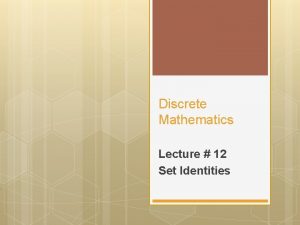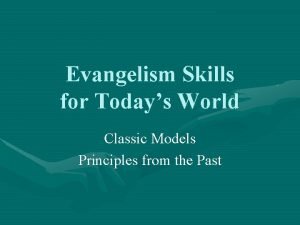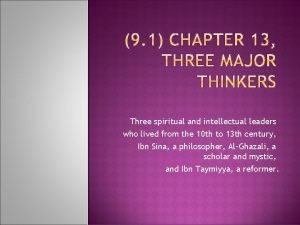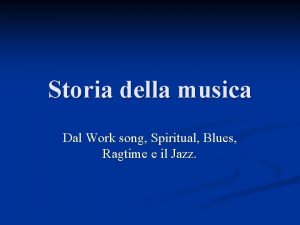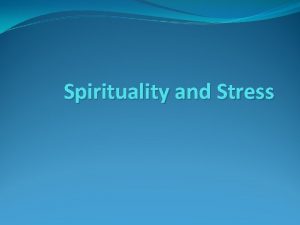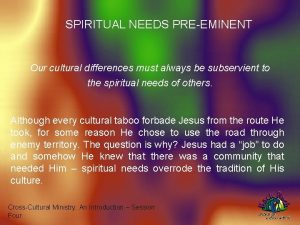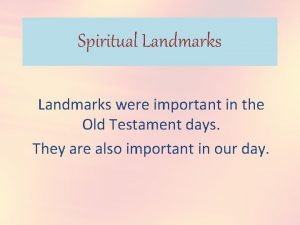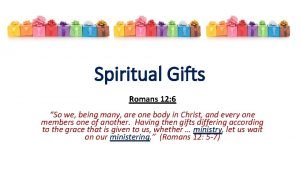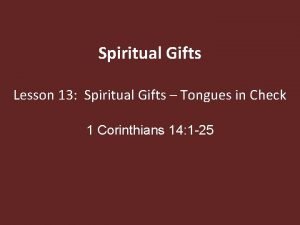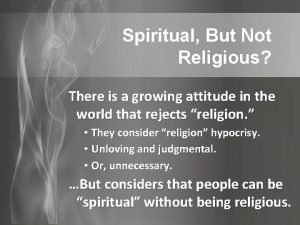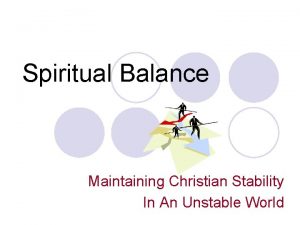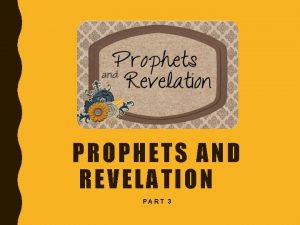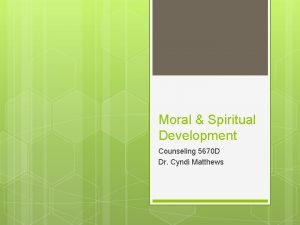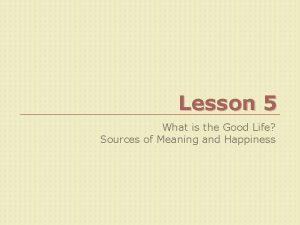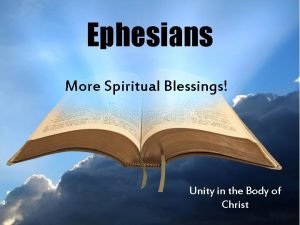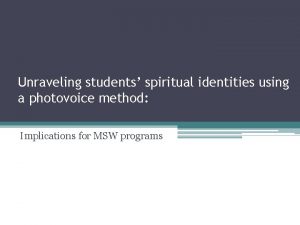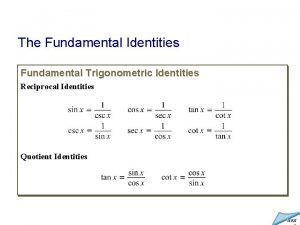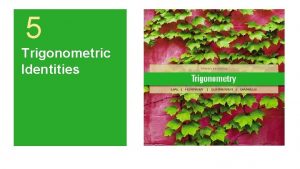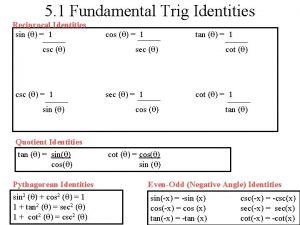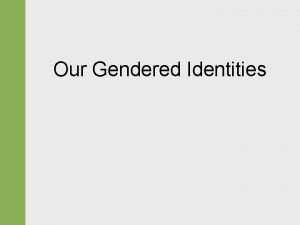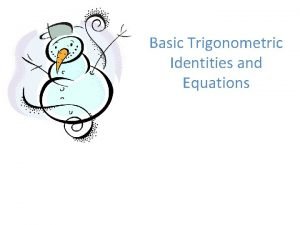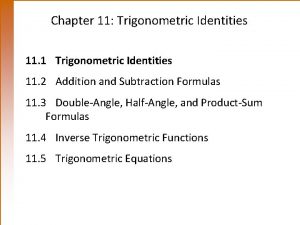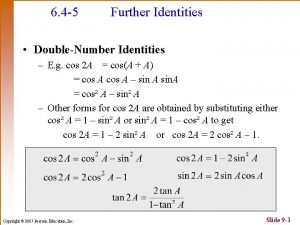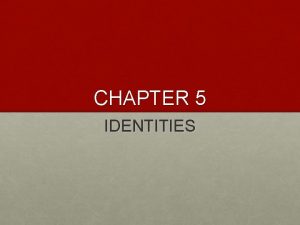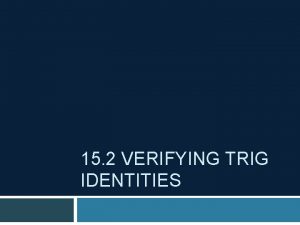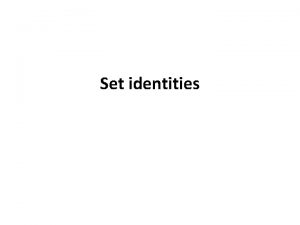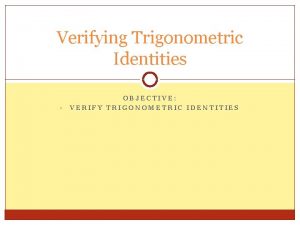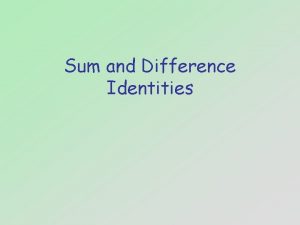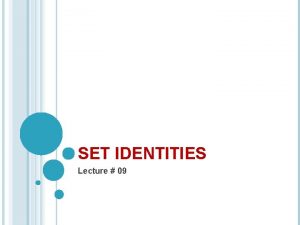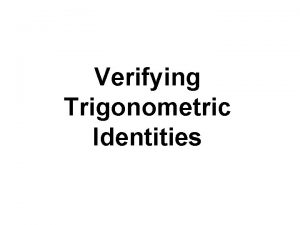Unraveling students spiritual identities using a photovoice method
































- Slides: 32

Unraveling students’ spiritual identities using a photovoice method: Implications for MSW programs

Overview • This research employed a photovoice method to explore 9 students’ (in this paper)experiences with spirituality and religion. • This paper highlights MSW students’ assessments of how spirituality and religion are addressed within the curriculum, as well as the contribution of spirituality and religion training to the preparation of social work practitioners.

Literature Review • Research has begun to increasingly examine clients’ spiritual and religious needs and how characteristics of the practitioners can relate to treatment processes (Cascio, 1999; Furman, Benson, Canda, & Grimwood, 2005; Rice & Mc. Auliffe, 2009; Sheridan, 2004). • Many social work curricula distance themselves from explicit training integrating religion and spirituality, which can create gaps in the training of professionals (Canda, 2005; Cnaan, Boddie & Dnazig, 2005; Lee, E. & Barrett, 2007).

Method • Photovoice, developed in the 1990’s by Wang and Burris, in which researchers provide questions or topic areas to participants and ask them to use a camera to capture a photographic response to the topic or question. • Data collected in multiple stages and waves

Research Question • In this phase of data collection participants were asked to take pictures in response to describing how they experienced spirituality / religion in the social work curriculum. • Specific prompt questions included but were not limited to: ▫ What have been your experiences of the integration of spirituality / religion in the social work classroom? ▫ What is your assessment of the nature of discussion about religion / spirituality in the social work program? ▫ What should be the role of religion/ spirituality in social work education? ▫ What does spirituality / religious training contribute to social work education?

Participants’ Characteristics • 3 first year MSW students • 6 final year MSW students (part-time and fulltime students) • All 9 identified a history with organized religion in childhood and/ or adulthood; all were Christian traditions • All were women, 7 White, 2 non-White • 1 had paid experience in the field of SW

Data Collection • This research used commonly accepted constructs of spirituality, including hope, meaning, and purpose, in assessing participants’ understanding of spirituality (Koenig & Spano, 2007). • Participants submitted photographs via email, followed by a debriefing session.

Findings • Sense of integration of religion and spirituality into MSW curriculum • What to integrate into a MSW curriculum • Where to integrate spirituality and religion into a curriculum • Significance of the professor

Sense of integration of religion and spirituality into MSW curriculum • Limited opportunities • Present but not addressed in many classes • Students not wanting to be spokespersons for their religious beliefs • Dependent on professor’s leadership and guidance

Sense of integration of religion and spirituality into MSW curriculum • “I feel like religion and spirituality are always totally present in this program, but are very seldom addressed”

Sense of integration of religion and spirituality into MSW curriculum • “It looks like just a snow hill, but we went sledding yesterday. That was a picture – I was trying to get a picture of a kid going down a jump, but I missed it because he flew by so fast, which is spirituality and religion in the classroom. I mean sometimes it was like ‘Oh, was it there? ’ (dramatic looking over the shoulder) but you don’t always catch it. ”

Sense of integration of religion and spirituality into MSW curriculum • “It’s a box because I find, in this program, um, the discussion of religion and spirituality is one everybody, well not everybody, but a lot of people want to keep it inside a box and they don’t want to open the lid and it’s very finite, it’s very right there, and it doesn’t go deep, it doesn’t go anywhere but right there. ”

Sense of integration of religion and spirituality into MSW curriculum • “As we talk about spirituality and religion in the classroom it very much is like ‘OK, this is going to be a touchy subject. ” And sometimes that instructor is from the instructor and sometimes that feeling is coming from the students. Sometimes an instructor thinks there is more openness around spirituality that religion… the word I kept thinking of was hesitancy. ”

Sense of integration of religion and spirituality into MSW curriculum • “I don’t see that there is any spiritual training in the program. So it’s kind of been sanitized away (laughter), like it’s clean. And again, it could be because of what I do [professionally] that I felt like I was doing the spiritual training in the classroom. ”

What to integrate into a MSW curriculum? • Spirituality in particular can’t necessarily be taught • Spiritual and religious beliefs and traditions should be acknowledged, incorporated as appropriate

What to integrate into a MSW curriculum? • “I have a ‘Do not enter’ sign… I don’t feel like spirituality should be taught. I feel like spirituality is more of a personal thing… I don’t feel like spirituality is one of things that you can teach. Like I feel like spirituality is more like personal, more like meditation practices or prayer… so I don’t think it should be taught. It should be like a self-guided thing. ”

What to integrate into a MSW curriculum? • “I think if it was named and talked about, just in real minor ways, it could be a light going off. Because I think we’re missing that. And I have a friend who’s a social worker and she has a counseling practice, and she said so many people come to here with spiritual problems or problems that were created in their youth in the way they were raised spiritually, and I don’t know if that’s true, but if we don’t know how to address those problems, it might be difficult for us.

What to integrate into a MSW curriculum? • I also think when people been traumatized in religion , and it’s not just people who have been sexually abused, but there’s other types of religion trauma, when you’re faced with that, as a therapist when a client comes in, that threatens your religious beliefs, your spiritual beliefs, just so you tend to shut down. And if we were able to, I don’t know what we would have to do to explore that, because anytime anyone starts questioning it may frighten the other person, but if we were open that might happen and it’s okay cause the spirit or God or whatever is bigger than anyone’s questions, and you’ll be okay, it would be like a light going off. It would be hard but these questions are part of being human. ”

What to integrate into a MSW curriculum? • “This picture I chose because-- well, it’s interesting that those are black--- but in many ways the majority of the students are coming from a Christian standpoint, so /I kind of represented those, like the majority. But then there’s all these other differences, but sometimes the differences aren’t heard…”

Where to integrate spirituality and religion into a curriculum? • In foundation classes: cultural competence, human behavior in the social environment (assessment) • In practice classes (intervention)

Where to integrate spirituality and religion into a curriculum? • “Well, I think this could be taught in the cultural competency class because in that class, I don’t know how many weeks it was, but it was a lot, and every week we focused on a different ethnic group or racial group or whatever, which was good, but we missed, I think, the opportunity to look at religious diversity. There were a few other groups in there that weren’t ethnic, but mostly it was. But if we took one week to talk about religious diversity and what my picture is is different religious books from different traditions.

Where to integrate spirituality and religion into a curriculum? • And I left out the main one, the Bible, because people are always already familiar with that. But I’ve got Buddha here and a book on Zen. Hafiz was a sufi mystic, he was a Muslim. Kundalini is the energy, the spiritual energy that’s released in yoga. Asi Es is Hispanic spirituality but it’s all from a Christian perspective, but it’s so different from European Christianity. The Goddess of the North is the feminist version of the--- Nordic paganism, it’s really big—and it’s just the feminist version of what happened to the goddesses. The witches bible is a very disturbing book to me because they do things ceremonious sky clad, which means nothing is worn. And, but if you don’t know those things happen and go on, then when somebody’s in your office and talking about being sky clad, you’re like, I still would probably get kind of creeped out about that [laughs]. And I think we should be exposed to that. Bhagavad Gita is the Hindu holy book. ”

Where to integrate spirituality and religion into a curriculum? • “I thought of it as like selfreflection, like they want you to do– I mean sometimes it seems all about selfreflection…thinking about yourself, like maybe why you believe certain things or have certain opinions. ”

Where to integrate spirituality and religion into a curriculum? • “I think spirituality should be taught in a variety of different ways. And while each lens does the same thing and camera does the same thing, it takes a picture, it does it in different ways. There’s so many different ways it could be taught. And I’m not sure what would be the best way, but I think there should be more than one. But some people don’t get, some people are more visual learners, some people are more read them, some people hear. So I think to get it, a full grasp of it, I think it needs to be done in a variety of different ways. ”

Where to integrate spirituality and religion into a curriculum? • “And I think it should be, religion should be taught with an open mind, an open door to anyone, to, while I might not have the most open mind about religion, um, I think I need to have more of an open mind because I could learn from someone else’s religion or viewpoints on religion. But a lot of times I’m very rigid in that, so it’s almost, I could learn something from that, but yet I’m reluctant. ”

Significance of the professor • Professors’ willingness to address this subject matter • Professors’ own values; how these relate to students’ values? • Dominance of Christianity or topic not addressed

Significance of the professor • “It’s really strange because this professor, and I’m not going to say who it is, but he claims to be a Christian and I am a Christian, consider myself, and he kind of quotes scriptures sometimes in class. And that’s not the problem I have at all, that’s who he is, that’s great. The problem I have is his [long pause] feelings towards clients and tells us a lot of personal things about his clients. And, I just think that’s disrespectful, first of all. And then, second of all, I think he’s really judging his clients. Cause last week he called one of his clients a loser [chuckles], and he wasn’t doing it in a joking way like “ha ha” or to prove a point or something. That was just really how he felt about his client. And it was very judgmental and negative. ”

Significance of the professor • “It was so hard to think of a picture for my concept. Cause my concept was like in my experience, not just in this program, but my entire college experience, has been the more rooted a professor is, the more open they are. Like if you have a professor that has tenure, and they’re not going to get fired for pretty much anything.

Significance of the professor • But, it’s been my experience that the longer a professor is here, the more open they are to share what they believe. Maybe it has to do with job security. So rooted, it was supposed to be like roots. How rooted a person is. Cause I know, like when professors have only been here a couple of semesters, you can tell they’re more hesitant to say things and will be like I don’t know if I’m supposed to say this. They’ll do that, they’ll say that in the middle of saying something. And you’re like, maybe you should know [laughs]. Or just say it and don’t care. But, yeah, so I think that was the concept, like tenure, rooted, involved. That was what I was trying to go for. ”

Significance of the professor • “And when professors bring it up, they’ll say ‘I’m not trying to make you feel one way or another– just throwing it out there. ’ And they always say ‘be respectful of other peoples’ opinions. ’ So, I think it goes well. It just surprises sometimes to hear people who aren’t always so considerate or always so compassionate. ”

Implications • Need to capture views of other students • Importance of inclusion of religious and spiritual traditions • Significance of the subject matter in a public university

• Council on Social Work Education, Annual Program Meeting • October, 2011 • Contact Information: ▫ Cray Mulder, Ph. D. , LMSW, muldecra@gvsu. edu ▫ Grand Valley State University, School of Social Work
 1 corinthians 2 9-13
1 corinthians 2 9-13 Caroline wang photovoice
Caroline wang photovoice What is photovoice
What is photovoice How to make a photovoice
How to make a photovoice A b discrete math
A b discrete math Vicenta ybardolaza description
Vicenta ybardolaza description Four spiritual laws evangelism method
Four spiritual laws evangelism method Euler modified method
Euler modified method Using questions to help students elaborate on content
Using questions to help students elaborate on content Symposium method of teaching
Symposium method of teaching What is direct method in language teaching
What is direct method in language teaching Prof. karl plotz
Prof. karl plotz Factual topics for group discussion
Factual topics for group discussion Using system.collections
Using system.collections Accumulator ac
Accumulator ac The intellectual and spiritual leaders
The intellectual and spiritual leaders Spiritual minded meaning
Spiritual minded meaning Work song blues
Work song blues Spiritual health definition
Spiritual health definition It fulfills the spiritual needs of a culture.
It fulfills the spiritual needs of a culture. Spiritual ancient landmark
Spiritual ancient landmark Romans 12 spiritual gifts
Romans 12 spiritual gifts Interpreting tongues lesson
Interpreting tongues lesson What are the 7 spiritual gifts
What are the 7 spiritual gifts Spiritual person definition
Spiritual person definition How to maintain spiritual stability
How to maintain spiritual stability Spiritual function of art
Spiritual function of art Three principles of acquiring spiritual knowledge
Three principles of acquiring spiritual knowledge What are the 7 spiritual gifts
What are the 7 spiritual gifts What is spiritual development
What is spiritual development Nothing in this world can fill the spiritual vacuum within
Nothing in this world can fill the spiritual vacuum within Spirtual usernames
Spirtual usernames Sunday spiritual blessings
Sunday spiritual blessings




